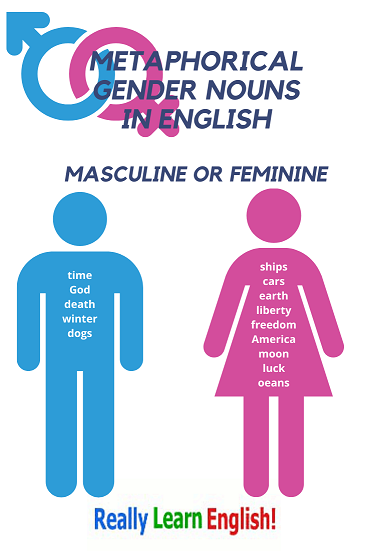Gender Nouns in English
Grammatical and Metaphorical
The modern English language is not known for having many gender-specific nouns, but they do exist.
There are actually four categories of gender nouns in English:
Masculine, feminine, common, and neuter. There are also metaphorical gender nouns in English.


In this lesson, we will discuss the differences among these categories of gender nouns and give you many examples.
Click Here for Step-by-Step Rules, Stories and Exercises to Practice All English Tenses
When learning English, you do not have to worry too much about noun gender and gender agreement because there are not many gender-specific nouns in English, and English nouns do not have to agree with a masculine or feminine adjective.
Unlike many other languages, English does not use grammatical gender, where every noun is assigned a gender regardless of whether that noun has a biological sex (gender).
In English, we assign natural genders to nouns, according to biological sex (gender).
Normally, nouns in English are only given a gender to refer to biological sex (male or female).
Noun genders in English
There are four genders of nouns
in English: - masculine
- feminine
- common
- neuter
Masculine nouns refer to a male figure or male member of a species: boy, father, rooster, king, actor, etc. These nouns are referred to as he, him, his, himself.
He is a
good dad.


Feminine nouns refer to a female figure or female member of a species: girl, mother, hen, queen, actress, etc. These nouns are referred to as she, her, hers, herself.
She is
talking to her
friend.


Nouns of common gender refer to members of a species, but they do not specify the gender (it can be male or female): child, parent, chicken, royalty, cat, etc.
These nouns are referred to as it, its, itself.
It is a fat
cat.
(We don't say if it is a female cat or a male cat.)

(We don't say if it is a female cat or a male cat.)

Some more examples:
| Feminine | Masculine | Common Gender |
| woman | man | person |
| mother | father | parent |
| girl | boy | child |
| sister | brother | sibling |
| wife | husband | spouse |
| hen | rooster | chicken |
Neuter nouns refer to things (inanimate objects) that do not have a gender: book, computer, pillow, window, tree, guitar. These nouns are referred to as it, its, itself.
It is an
old book.


In many other languages, nouns that are neuter in English are given a specific gender, either feminine or masculine and are paired with gender specific adjectives, articles, etc.
Spanish, French, German, Italian, Russian, and Hebrew are a few languages that assign a masculine or feminine gender to nouns that are neuter in English.
This does not mean that these objects are physically masculine or feminine, but they are grammatically paired with articles and adjectives that match their grammatical gender.
For example, in Spanish book is libro and is a masculine noun.
Guitar is guitarra and is a feminine noun.
They are both paired with the correct form of the article the (el or la) to match their gender: el libro and la guitarra.
But English is different. Although there are some nouns that refer to a specific gender such as boy and girl, articles and adjectives do not have a specific gender.
For example, boy is masculine and girl is feminine, but both can be paired with the article the (the boy or the girl), and almost any adjective (the cute boy or the cute girl).

Metaphorical genders in English
Why are countries and nations like America usually referred to as she?
Why is freedom often referred to as she?

These exceptions to natural biological gender rules in English are called metaphorical gender.
Metaphorical gender is normally used for poetic effect (to show imagination and feeling). In other words, it is used in order to personify objects or concepts, and show strong emotional attachments to them. (To personify an object means to give it human characteristics.)
Since many English nouns do not have a grammatical gender, English speakers and writers can personify objects as whichever gender they choose.
Most of the time, the gender assigned is female, but a few inanimate objects are commonly given a male gender.
Please note that the use of he or she for inanimate objects is not as common in modern English. It is often considered old-fashioned and sometimes offensive.
However, English language learners should still be aware of this practice. It helps readers comprehend figurative language in writing and poetry, and this practice is still used in some varieties of English.
Let's look at a few of the most common metaphorical gender nouns.
Masculine metaphorical nouns
- God
- Time (Father Time)
- Death
- Dogs (when the gender is not known)
- Winter (Old man winter)

Feminine metaphorical nouns
- Nature (Mother Nature)
- Earth (Mother Earth)
- Countries/Nations (America, England)
- Liberty (Lady Liberty)
- Cars
- Freedom
- Ocean/Sea
- Justice (Lady Justice)
- Luck (Lady Luck)
- Moon
- Storms/Hurricanes
- Boats and Ships

Vehicles, including ships, cars, and trains often take a metaphorical feminine gender, especially when spoken or written about by men.

Get Updates, Special Offers, and English Resources
Download your FREE GIFT (the first two chapters of
English Short Stories Book and Workbook)
as soon as you join!

By submitting your email, you consent to receiving updates and newsletters from us and to the sharing of your personal data with third parties for the purposes of sending you communications. We will not spam you. You can unsubscribe at any time. For more information, please see our privacy policy.
Return from Gender Nouns in English to English Grammar Center





